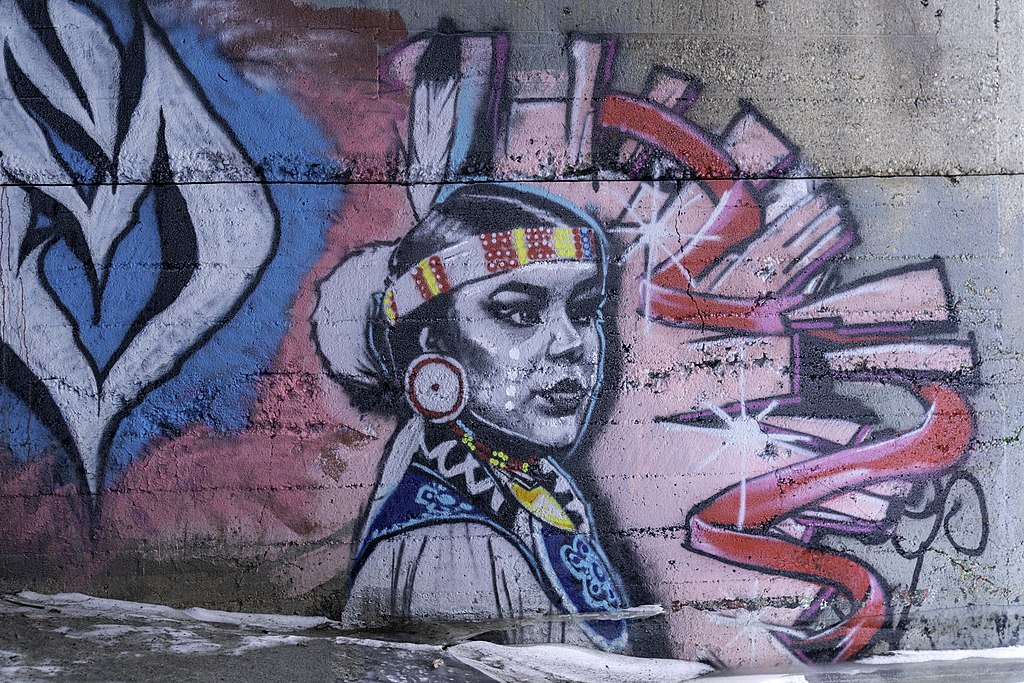Urban Indigenous Peoples
Disclaimer: In this section you will see statistical information that is compiled in part by Environics. Bear in mind that statistics are sometimes useful for identifying certain trends and characteristics. Statistics don’t tell the whole story, and don’t necessarily ask questions that Indigenous nations would ask their own people. Furthermore, the onus is on participants to self-identify–which can be problematic–in that Nationhood is necessarily determined by the Nation itself, not individuals.
In 2016, almost 900,000 Indigenous people lived in urban areas (towns and cities with a population of 30,000 or more), accounting for more than half of Indigenous people in Canada. They are often referred to as “Urban Indigenous peoples.” The largest Urban Indigenous populations are in Winnipeg, Edmonton, Vancouver, Calgary, and Toronto.
Many Indigenous people move to cities seeking employment or educational opportunities. Some have lived in cities for generations, while for others the transition from rural areas or reserves to urban settings is still very new. Many Canadian cities occupy the traditional territories of Indigenous peoples and sometimes reserves of First Nations are embedded within the city itself. For example, Winnipeg lies on the traditional territory of the Anishinaabe (Ojibway), Ininew (Cree), Oji-Cree, Dene, and Dakota, and is the Birthplace of the Métis Nation and the Heart of the Métis Nation Homeland. Most Urban Indigenous peoples consider the city they live in to be their “home.” However, for many it is also important to keep a close connection to the Indigenous community of their family’s origin. This could be the place where they were born or where their parents or grandparents lived. Connection to these communities helps many people retain their traditional and contemporary Indigenous culture.
Urban Indigenous peoples in Winnipeg
The Urban Indigenous peoples in Winnipeg are an important and visible part of the city’s life. However, the majority believe they are viewed in negative ways. Despite this, according to the Urban Indigenous Peoples Study: Winnipeg (2011), among Indigenous people
- 72 per cent are “very proud” of their First Nations/Métis/Inuk identity
- 78 per cent are “very proud” of being Canadian
- 46 per cent are not concerned about losing their cultural identity; they feel it is strong enough to continue and that they can protect it
- 54 per cent think Indigenous culture has become stronger in the last five years
- 55 per cent prioritize that young people from the next generation stay connected to their cultural family values, and
- 93 per cent believe there is unfair or discriminatory treatment by non-Indigenous people.
The Urban Aboriginal Peoples Survey by Environics has researched several Canadian cities and results do vary from city to city. In terms of overall results for Canada, urban Indigenous peoples are generally proud to be First Nations, Métis, or Inuk (82%). This finding is particularly true for Inuit (91% are very proud), while First Nations (88%) and Métis (77%) follow closely behind. Métis pride is strongest in Calgary, Regina, Winnipeg, Toronto, and Halifax, where it is equivalent to that of First Nations. It is noteworthy that status and non-status First Nations peoples demonstrate pride that is very similar in strength.

Urban Indigenous Peoples in Brandon1
The City of Brandon takes into account information provided by the Brandon Urban Aboriginal Peoples Council (BUAPC). This community-based organization surveyed a diverse population of Brandon residents in educational settings in 2015 and presented its findings:
- The percentage of the population that identifies as Indigenous in Brandon is between 10-15% depending on the time of year as it pertains to cycles of the educational year and employment availability.
- Nearly 52% of respondents felt that Indigenous people received some recognition when they brought forward concerns, while nearly 33% felt that FNMI concerns received little attention. Respondents’ comments on this question included that Indigenous-related events were covered for negative reasons rather than telling positive stories. Participants expressed dismay that political rhetoric linked to the concerns of Indigenous peoples, especially at election times, was quickly forgotten once elections were over. In general, too much talk and not enough action is tied to Indigenous matters.
- When asked which social issues are most closely tied to the economic development (success) of Indigenous people in Brandon, the top responses were availability of affordable housing for those that may need that resource, presence of negative stereotypes, and availability of quality childcare.
- Indigenous peoples in Brandon are involved in all kinds of community groups and organizations, some of which include charities or social organizations, youth groups, ethnic groups, business organizations, sports clubs or leagues, professional or farm associations, music or arts-based groups, and many more.
Media Attributions
‘Graffiti of an Indigenous Woman in Winnipeg’ (Lorie Schaull) is licensed under a CC BY-NC-SA (Attribution Non-Commercial Share Alike) License.
Notes
- Statistical information and analysis provided by Brandon Urban Aboriginal Peoples Council from a study completed in 2015 [unpublished].

